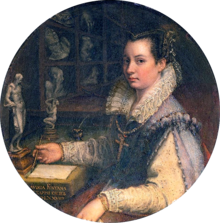Lavinia Fontana
Lavinia Fontana (24 August 1552–11 August 1614) was an Italian Mannerist painter. She was active in Bologna and Rome. Today, people remember her mostly for the portraits that she painted. She also had other themes that she painted. She also did mythological and religious painting. Her father, Prospero Fontana trained her. Some people see her as the first career artist in Europe. This is because she relied on commissions for her income.[1][2] In the context of art, this means that people asked her to create paintings with certain themes or styles, and paid for this.
Lavinia Fontana | |
|---|---|
 Self-Portrait in the Studio, 1579 | |
| Born | |
| Baptised | 24 August 1552 |
| Died | (aged 61) Rome, Papal States |
| Resting place | Santa Maria sopra Minerva, Rome |
| Education | |
| Alma mater | University of Bologna |
| Style | Mannerist |
| Spouse |
Gian Paolo Zappi (m. 1577) |
| Children | 11 |
| Parent |
|
| Elected | Accademia di San Luca |
| Patron(s) | |
Her family relied on her career as a painter, and her husband served as her agent and raised their eleven children.[3] She was perhaps the first female artist to paint female nudes, but this is a topic of controversy among art historians.[4]
Her nude paintings
changeFontana also pained nudes. Today, art historians do not agree on the ways and means she used for this.[1] She had studied her father's collection of sculptures and plaster casts. The problem is that during Fontana's lifetime, it was socially unaceptable for women to be exposed to nudity. If it was discovered that Fontana used live nude models, this would harm her reputation. Liana De Girolami Cheney argues the figures look very natural. According to her, this might indicate that Fontana used live nude models.[5] Caroline P. Murphy says that much like with her Fontana's father's paintings, the body parts are well-rendered, but overall, the figure re disproportionate. Murphy suggests that, like Sofonisba Anguissola, Fontana had family members model for her.[6] Linda Nochlin writes that art academies barred women from viewing any nude body, despite this being a crucial part of an artist's training.[7]
Gallery
change-
Assumption of the Virgin with Saints Peter Chrysologus and Cassian, 1584, Palazzo Comunale, Imola
-
Portrait of Costanza Alidosi, c. 1595, National Museum of Women in the Arts, Washington, D.C.
-
Christ and the Samaritan Woman at the Well, unknown date, private collection
-
Judith and Holofernes, unknown date, private collection
-
Portrait of Bianca Lucia Aliprandi, 1602, private collection
-
Wedding Feast at Cana, c. 1575–1580, J. Paul Getty Museum, Los Angeles
References
change- Chadwick, Whitney (1990). Women, Art, and Society. London: Thames and Hudson. ISBN 9780500202418.
- Cheney, Liana (Spring-Summer 1984). "Lavinia Fontana, Boston 'Holy Family'". Woman's Art Journal. 5 (1).
- Cheney, Liana De Girolami; Faxon, Alicia Craig; Russo, Kathleen Lucey (2000). Self-Portraits by Women Painters. Singapore: Ashgate. ISBN 978-1-85928-424-7.
- Findlen, Paula (8 November 2002). The Italian Renaissance. Wiley. ISBN 978-0-631-22283-5.
- Fortunati, Vera (1998). Lavinia Fontana of Bologna (1552–1614). Milan: Electa. ISBN 978-8843563944.
- Gaze, Delia. Concise Dictionary of Women Artists.
- Hansen, Morten Steen; Spicer, Joaneath, eds. (2005). Masterpieces of Italian Painting, The Walters Art Museum. Baltimore and London. ISBN 978-1904832140.
{{cite book}}: CS1 maint: location missing publisher (link) - Harris, Anne Sutherland; Nochlin, Linda (1976). Women Artists: 1550-1950. New York: Los Angeles County Museum of Art.
- Murphy, Caroline P. (1996). "Lavinia Fontana and 'Le Dame della Citta': understanding female artistic patronage in late sixteenth-century Bologna." Renaissance Studies. 10 (2). pp. 190–208. JSTOR.
- Murphy, Caroline P. (1997). "Lavinia Fontana". Dictionary of Women Artists. Vol 1. Delia Gaze, ed. Chicago: Fitzroy Dearborn. pp. 534–7. ISBN 1-884964-21-4.
- Murphy, Caroline P. (2003). Lavinia Fontana: A Painter and Her Patrons in Sixteenth-century Bologna. Yale University Press. ISBN 978-0-300-09913-3.
- Rocco, Patricia. The Devout Hand: Women, Virtue, and Visual Culture in Early Modern Italy. McGill-Queens University Press, 2017.
- Smyth, Francis P.; O'Neill, John P. (1986). The Age of Correggio and the Carracci: Emilian Painting of the 16th and 17th Centuries. Washington DC: National Gallery of Art. pp. 132–136.
Other websites
change- ↑ 1.0 1.1 Murphy, Caroline P. (2003). Lavinia Fontana: A Painter and Her Patrons in Sixteenth-Century Bologna. New Haven, CT: Yale University Press. pp. 30. ISBN 978-0-300-09913-3.
- ↑ "Artist Profile: Lavinia Fontana". National Museum of Women in the Arts. Retrieved 29 March 2013.
- ↑ Weidemann, Christiane; Larass, Petra; Melanie, Klier (2008). 50 Women Artists You Should Know. Prestel. pp. 18, 19. ISBN 978-3-7913-3956-6.
- ↑ De Girolami Cheney, Liana (2015). "Lavinia Fontana's nude Minervas". Woman's Art Journal: 32. ISSN 0270-7993. OCLC 956553105.
- ↑ Cheney, Liana De Girolami. "Lavinia Fontana's Nude Minervas". Woman's Art Journal. 36 (2): 30–40.
- ↑ Murphy, Caroline P. (2003). Lavinia Fontana: A Painter and Her Patrons in Sixteenth-Century Bologna. Singapore: Yale University Press. pp. 21–2. ISBN 978-0-300-09913-3.
- ↑ Nochlin, Linda (1988). "Why Have There Been No Great Women Artists?". Women, Art, and Power and Other Essays. New York: Harper & Row. pp. 158–61. ISBN 9780064358521.
- Media related to Paintings by Lavinia Fontana at Wikimedia Commons
- Orazio and Artemisia Gentileschi, a fully digitized exhibition catalog from The Metropolitan Museum of Art Libraries, which contains material on Lavinia Fontana (see index)